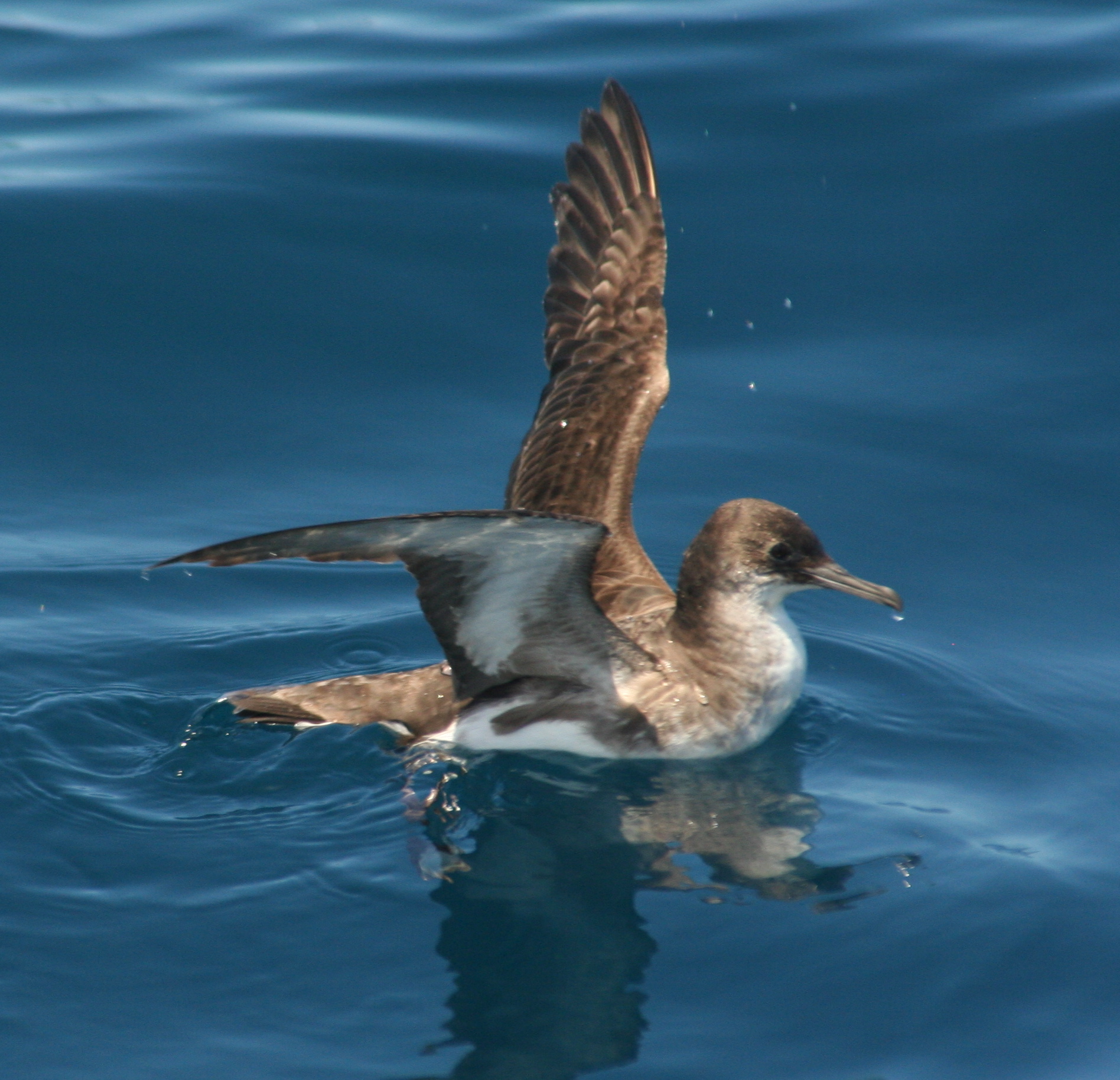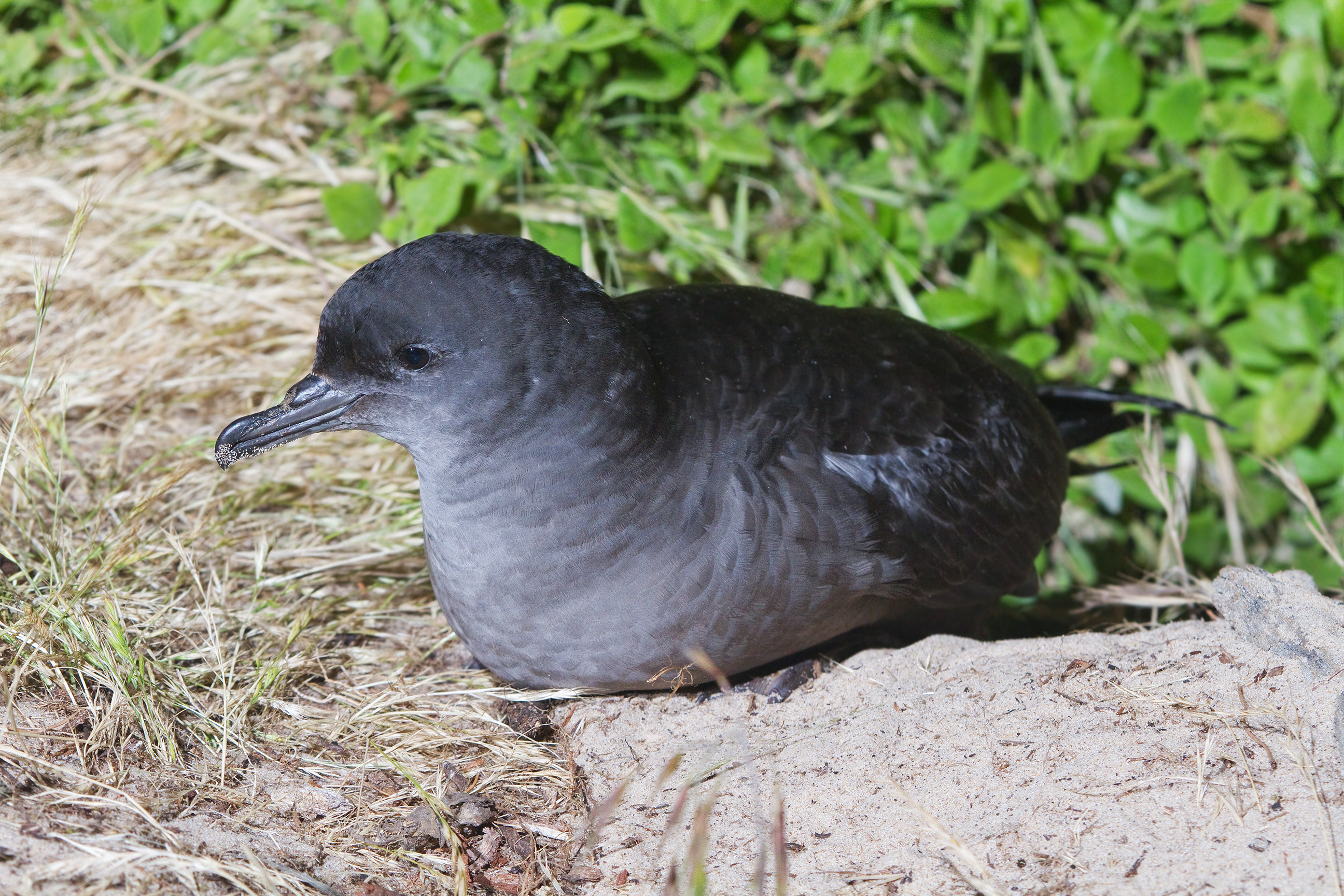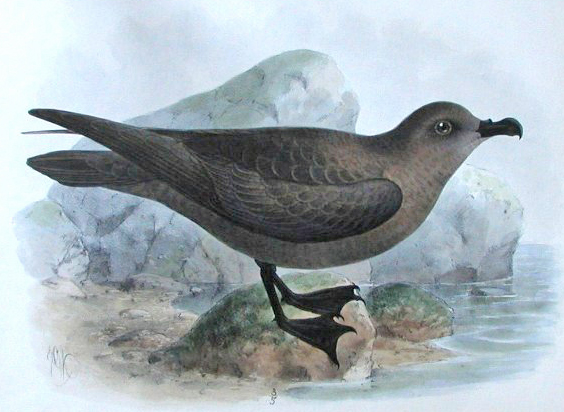|
Puffinus
''Puffinus'' is a genus of seabirds in the order Procellariiformes that contains about 20 small to medium-sized shearwaters. Two other shearwater genera are named: '' Calonectris'', which comprises three or four large shearwaters, and '' Ardenna'' with another seven species (formerly often included within ''Puffinus''). The taxonomy of this group is the cause of much debate, and the number of recognised species varies with the source. The species in this group are long-winged birds, dark brown or black above, and white to dark brown below. They are pelagic outside the breeding season. They are most common in temperate and cold waters. These tubenose birds fly with stiff wings, and use a shearing flight technique to move across wave fronts with the minimum of active flight. Some small species, such as the Manx shearwater, are cruciform in flight, with their long wings held directly out from their bodies. Many are long-distance migrants, perhaps most spectacularly the sooty an ... [...More Info...] [...Related Items...] OR: [Wikipedia] [Google] [Baidu] |
Shearwater
Shearwaters are medium-sized long-winged seabirds in the petrel family Procellariidae. They have a global marine distribution, but are most common in temperate and cold waters, and are pelagic outside the breeding season. Description These tubenose birds fly with stiff wings and use a "shearing" flight technique (flying very close to the water and seemingly cutting or "shearing" the tips of waves) to move across wave fronts with the minimum of active flight. This technique gives the group its English name. Some small species, like the Manx shearwater are cruciform in flight, with their long wings held directly out from their bodies. Behaviour Movements Many shearwaters are long-distance migrants, perhaps most spectacularly sooty shearwaters, which cover distances in excess of from their breeding colony on the Falkland Islands (52°S 60°W) to as far as 70° north latitude in the North Atlantic Ocean off northern Norway. One study found Sooty shearwaters migrating nearly a ... [...More Info...] [...Related Items...] OR: [Wikipedia] [Google] [Baidu] |
Manx Shearwater
The Manx shearwater (''Puffinus puffinus'') is a medium-sized shearwater in the seabird family Procellariidae. The scientific name of this species records a name shift: Manx shearwaters were called Manks puffins in the 17th century. Puffin is an Anglo-Norman word (Middle English ''pophyn'') for the cured carcasses of nestling shearwaters. The Atlantic puffin acquired the name much later, possibly because of its similar nesting habits. Taxonomy The shearwaters form part of the family Procellariidae, a widespread group containing nearly 100 species of medium to large seabirds. They have long, narrow wings and the characteristic “tube nose”. Although it was considered a monotypic species, recently an endemic subspecies for the Canary Islands has been proposed ''P. puffinus canariensis''. The large genus ''Puffinus'' includes several species formerly considered to be subspecies of the Manx shearwater, including the yelkouan shearwater, Balearic shearwater, Hutton's shearwate ... [...More Info...] [...Related Items...] OR: [Wikipedia] [Google] [Baidu] |
Fluttering Shearwater
The fluttering shearwater (''Puffinus gavia'') is a species of seabird in the family Procellariidae. It is endemic to New Zealand and migrates to Australia and the Solomon Islands. Its natural habitats are open seas and rocky shores. It has been known as Forster's shearwater in the past. Description A medium to small-sized shearwater with dark-brown-and-white colour in body. The upper parts, including neck, wings and tail, are uniformly dark brown. Grey-brown colour in face and neck gradually fading into white below the eye. Under body, from chin to the under-tail, is white except for a dark thigh patch that can be seen in flight. Bottom wing commonly white while axillary area is covered in grey-brown fur. Under light conditions, the appearance can changed. Fluttering shearwater has pinkish-brown legs and feet with bark webs, feet extend beyond the tail in flight. The bill is long and thin with dark colour. The tail is fan-shaped and short in flight and it has mixed colour ... [...More Info...] [...Related Items...] OR: [Wikipedia] [Google] [Baidu] |
Short-tailed Shearwater
The short-tailed shearwater or slender-billed shearwater (''Ardenna tenuirostris''; formerly ''Puffinus tenuirostris''), also called yolla or moonbird, and commonly known as the muttonbird in Australia, is the most abundant seabird species in Australian waters, and is one of the few Australian native birds in which the chicks are commercially harvested. It is a migratory species that breeds mainly on small islands in Bass Strait and Tasmania and migrates to the Northern Hemisphere for the boreal summer. Taxonomy This shearwater appears to be related to the sooty and great shearwaters, which are also blunt-tailed, black-billed species, but its precise relationships are obscure (Austin, 1996; Austin ''et al.'', 2004). These are among the larger species of shearwater, which have been moved to a separate genus, ''Ardenna'' based on a phylogenetic analysis of mitochondrial DNA (Penhallurick & Wink, 2004). Ecology Each parent feeds the single chick for 2–3 days and then leav ... [...More Info...] [...Related Items...] OR: [Wikipedia] [Google] [Baidu] |
Sooty Shearwater
The sooty shearwater (''Ardenna grisea'') is a medium-large shearwater in the seabird family Procellariidae. In New Zealand, it is also known by its Māori name , and as muttonbird, like its relatives the wedge-tailed shearwater (''A. pacificus'') and the Australian short-tailed shearwater (''A. tenuirostris''). Taxonomy The sooty shearwater was formally described in 1789 by the German naturalist Johann Friedrich Gmelin under the binomial name ''Procellaria grisea''. The shearwater had been briefly described in 1777 by James Cook in the account of his second voyage to the Pacific, and in 1785 the English ornithologist John Latham had described a museum specimen. The sooty shearwater is now placed in the genus '' Ardenna'', that was introduced in 1853 by Ludwig Reichenbach. The genus name ''Ardenna'' was used to refer to a seabird by Italian naturalist Ulisse Aldrovandi in 1603, and the specific epithet ''grisea'' is medieval Latin for "grey". The species is considere ... [...More Info...] [...Related Items...] OR: [Wikipedia] [Google] [Baidu] |
Ardenna
''Ardenna'' is a genus of seabirds in the family Procellariidae. These medium-sized shearwater species were formerly included in the genus '' Puffinus''. Taxonomy A phylogenetic analysis using mitochondrial DNA published in 2004 found that ''Puffinus'' contained two distinct clades and was polyphyletic. To create monophyletic genera a group of species were moved into ''Ardenna'', a genus that had been introduced in 1853 by Ludwig Reichenbach with the great shearwater as the type species. Reichenbach cites the Italian naturalist Ulisse Aldrovandi Ulisse Aldrovandi (11 September 1522 – 4 May 1605) was an Italian naturalist, the moving force behind Bologna's botanical garden, one of the first in Europe. Carl Linnaeus and the comte de Buffon reckoned him the father of natural history s ... who in 1603 used the spelling "Artenna" for a seabird. Recent genomic studies have validated the phylogenetic distinction between ''Ardenna'' and ''Puffinus''. Species The genus contains ... [...More Info...] [...Related Items...] OR: [Wikipedia] [Google] [Baidu] |
Calonectris
''Calonectris'' is a genus of seabirds. The genus name comes from Ancient Greek ''kalos'', "good" and ''nectris'', "swimmer". The genus comprises four large shearwaters. There are two other shearwater genera. ''Puffinus'', which comprises about twenty small to medium-sized shearwaters, and ''Procellaria ''with another four large species. The latter are usually named as ''petrels'', although they are thought to be more closely related to the shearwaters than to the other petrels. The species in this group are long-winged birds, dark brown or grey-brown above, and mainly white below. They are pelagic outside the breeding season. They are most common in temperate and cold waters. These tubenose birds fly with stiff wings, and use a shearing flight technique to move across wave fronts with the minimum of active flight. Their flight appears more albatross-like than the ''Puffinus'' species. ''Calonectris'' shearwaters are long-distance migrants. The streaked shearwater disperse ... [...More Info...] [...Related Items...] OR: [Wikipedia] [Google] [Baidu] |
Procellariiformes
Procellariiformes is an order of seabirds that comprises four families: the albatrosses, the petrels and shearwaters, and two families of storm petrels. Formerly called Tubinares and still called tubenoses in English, procellariiforms are often referred to collectively as the petrels, a term that has been applied to all members of the order,Warham, J. (1996). ''The Behaviour, Population, Biology and Physiology of the Petrels''. London: Academic Press, or more commonly all the families except the albatrosses.Brooke, 2004. They are almost exclusively pelagic (feeding in the open ocean), and have a cosmopolitan distribution across the world's oceans, with the highest diversity being around New Zealand. Procellariiforms are colonial, mostly nesting on remote, predator-free islands. The larger species nest on the surface, while most smaller species nest in natural cavities and burrows. They exhibit strong philopatry, returning to their natal colony to breed and returning to th ... [...More Info...] [...Related Items...] OR: [Wikipedia] [Google] [Baidu] |
Seabird
Seabirds (also known as marine birds) are birds that are adapted to life within the marine environment. While seabirds vary greatly in lifestyle, behaviour and physiology, they often exhibit striking convergent evolution, as the same environmental problems and feeding niches have resulted in similar adaptations. The first seabirds evolved in the Cretaceous period, and modern seabird families emerged in the Paleogene. In general, seabirds live longer, breed later and have fewer young than other birds do, but they invest a great deal of time in their young. Most species nest in colonies, which can vary in size from a few dozen birds to millions. Many species are famous for undertaking long annual migrations, crossing the equator or circumnavigating the Earth in some cases. They feed both at the ocean's surface and below it, and even feed on each other. Seabirds can be highly pelagic, coastal, or in some cases spend a part of the year away from the sea entirely. Seabirds ... [...More Info...] [...Related Items...] OR: [Wikipedia] [Google] [Baidu] |
Bird Migration
Bird migration is the regular seasonal movement, often north and south along a flyway, between breeding and wintering grounds. Many species of bird migrate. Migration carries high costs in predation and mortality, including from hunting by humans, and is driven primarily by the availability of food. It occurs mainly in the northern hemisphere, where birds are funneled onto specific routes by natural barriers such as the Mediterranean Sea or the Caribbean Sea. Migration of species such as storks, turtle doves, and swallows was recorded as many as 3,000 years ago by Ancient Greek authors, including Homer and Aristotle, and in the Book of Job. More recently, Johannes Leche began recording dates of arrivals of spring migrants in Finland in 1749, and modern scientific studies have used techniques including bird ringing and satellite tracking to trace migrants. Threats to migratory birds have grown with habitat destruction, especially of stopover and wintering sites, a ... [...More Info...] [...Related Items...] OR: [Wikipedia] [Google] [Baidu] |
Bird
Birds are a group of warm-blooded vertebrates constituting the class Aves (), characterised by feathers, toothless beaked jaws, the laying of hard-shelled eggs, a high metabolic rate, a four-chambered heart, and a strong yet lightweight skeleton. Birds live worldwide and range in size from the bee hummingbird to the ostrich. There are about ten thousand living species, more than half of which are passerine, or "perching" birds. Birds have whose development varies according to species; the only known groups without wings are the extinct moa and elephant birds. Wings, which are modified forelimbs, gave birds the ability to fly, although further evolution has led to the loss of flight in some birds, including ratites, penguins, and diverse endemic island species. The digestive and respiratory systems of birds are also uniquely adapted for flight. Some bird species of aquatic environments, particularly seabirds and some waterbirds, have further evolved for swimm ... [...More Info...] [...Related Items...] OR: [Wikipedia] [Google] [Baidu] |
Clade
A clade (), also known as a monophyletic group or natural group, is a group of organisms that are monophyletic – that is, composed of a common ancestor and all its lineal descendants – on a phylogenetic tree. Rather than the English term, the equivalent Latin term ''cladus'' (plural ''cladi'') is often used in taxonomical literature. The common ancestor may be an individual, a population, or a species (extinct or extant). Clades are nested, one in another, as each branch in turn splits into smaller branches. These splits reflect evolutionary history as populations diverged and evolved independently. Clades are termed monophyletic (Greek: "one clan") groups. Over the last few decades, the cladistic approach has revolutionized biological classification and revealed surprising evolutionary relationships among organisms. Increasingly, taxonomists try to avoid naming taxa that are not clades; that is, taxa that are not monophyletic. Some of the relationships between org ... [...More Info...] [...Related Items...] OR: [Wikipedia] [Google] [Baidu] |







.jpg)